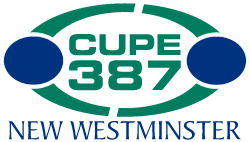Executive
CUPE 387 members elect an executive board that is responsible for the local. The executive conducts union business, represents the union in collective bargaining, works for the best interest of its members and is at all times accountable to the members. Meetings are held regularly and Elections are held at the annual general meeting.
2024-2025 Executive
Table Officers
Executive Directors
 | Michael Racanello | mracanello@cupe387.ca | ||
| Monique Ferbey | mferbey@cupe387.ca | |||
 | Brian Tompkins | btompkins@cupe387.ca | ||
 | Sage Deluce | sdeluce@cupe387.ca |
Trustees
- Catherine Lindsay
- Darryl Peterson
- Johnny Tran
More About Your Executive
Stewards
Stewards are often the first point of contact for our members when engaging with the local and are the union representatives in the workplace. If you are in need of steward support or are interested in becoming a steward, contact the Union Office.
Steward Responsibilities
- Provides support for members
- Helps clarify responsibilities and benefits laid out within the collective agreement
- Is the Union representative for any disciplinary meetings
- Receives basic steward training
| NAME | CITY DEPARTMENT | ||
|---|---|---|---|
| Gavin Hermanson | Union Office | ||
| Jay DeCoursey | Engineering Operations | ||
| Jessica Adam | Recreation | ||
| Michael Racanello | CAPD | ||
| Michelle Edwardsen | Parks | ||
| Monique Ferbey | Finance | ||
| Tabitha Guichon | Engineering Operations | ||
| Sage Deluce | Parks | ||
| Brian Tompkins | Parks |
Committees
Committee members are appointed by the Executive and help the Executive with various aspects of running the Union. If you wish to serve on a committee, please contact the Union Office.
Committees
Committee Members
Bargaining Preparation Committee Full Executive
Bylaw Committee Tabitha Guichon
Jessica Adam
Finance Committee Gavin Hermanson
Jay DeCoursey
Jessica Adam
Michelle Edwardsen
Tabitha Guichon
Grievance Committee Gavin Hermanson
Brian Tompkins
Michelle Edwardsen
Health and Safety Committee Sage Deluce
Gavin Hermanson
Long Term Total Disability Committee TBD
Public Relations Committee Tabitha Guichon
Jessica Adam
Negotiating Committee Michelle Edwardsen
Tabitha Guichon
Gavin Hermanson
Chris Losito (CUPE National)
Joining on a rotational basis:
Jay DeCoursey
Brian Tompkins
Sage Deluce
Education Committee Tabitha Guichon
Michelle Edwardsen
New West District Labour Council Gavin Hermanson
Metro Vancouver District Council Michelle Edwardsen
Labour Management Committees
| Department | Union Representatives |
|---|---|
| Anvil Centre | Gavin Hermanson Mike Racanello |
| City Hall | Gavin Hermanson Monique Ferbey |
| Engineering Operations | Gavin Hermanson Jay DeCoursey Michelle Edwardsen |
| Library | Michelle Edwardsen Gavin Hermanson Zaria Alibhai |
| Parks | Michelle Edwardsen Brian Tompkins Sage Deluce (Alternate) |
| Recreation | Jessica Adam Gavin Hermanson |
| Police | Tabitha Guichon Gavin Hermanson |
About CUPE 387
CUPE 387’s roots date back over 100 years to union organization in New Westminster during the fiscal crisis in World War I.
After September 1914 the local economy declined precipitously as governments attempted to redirect capital into the war effort. City revenues fell, while inflation rose.
In 1915/16 there were a number of financial assaults against city workers.
- City council ordered that all current employees take two weeks unpaid holiday, in lieu of a reduction in wages.
- Staff was cut.
- The Board of Trade passed a resolution on retrenchment and reduced taxation.
- The newly formed Ratepayers Association complained to City Council that taxes were too high, salaries were too high, departments were too many and officials were too many.
- Early in 1916 Council caved to pressure and wages for city workers were drastically reduced.
One of the effected groups was the Light Department. Represented since 1913 by IBEW (International Brotherhood of Electrical Workers), the linemen objected to the wage reduction. Various attempts to challenge this ruling including presentations by the linemen and the Union to Council and the Light Committee failed. The linemen took a one day “holiday” and were fired. Further attempts to resolve the dispute failed.
In the middle of the dispute between the linemen and Council, the seeds for the formation of a civic union were sown. On February 22, 1916, the day after Council refused the first request for a wage increase for linemen, the New Westminster and District Labour Council met and delegates suggested it was time for New Westminster civic workers to form a union.
On March 9, the New Westminster Trades and Labour Council voted to organize the civic workers and a committee was appointed to meet the workers and receive their support for the organization of a union.
The Columbian of June 6, 1916 noted that on June 3 the newly organized Municipal Employees Association had met and elected their first executive and had 40 members. Its status as a union was also noted in the 1916 edition of Annual Report of Labour Organizations.
The new Association was an open shop union meaning it was voluntary whether to belong or not. The union was open to all the employees of the City, excluding the essential services of Fire and Police, but including those of the Light or Electrical Department.
Over the next few years the Association made several appeals to Council for additional time off and increased wages, with varying results.
The fiscal crisis deepened in 1917. In retrospect, the turning point in the crisis had been reached but the cost of living had increased by 18 percent in 1916 and by 40 percent by the end of 1917. The workers’ appeals had some effect as at some point in 1917 the wages were increased and by August 1918 were returned to slightly above what they were when the fiscal crisis began two years earlier. In the ensuing years the Association continued to work on its members behalf.
In 1942, Ray Mercer met with Mayor Hume to announce that he would be organizing the members of the Association into a closed shop union.
On July 12, 1943, the Secretary of the Association requested the cooperation of the Council in having superintendents of the civic departments encourage all employees to become members of the Civic Employees’ Association and Council passed the resolution. With a closed shop union came formal negotiations followed by written contacts.
In August, 1945 the word “Union” appears for the first time instead of Association.
In 1948, the electrical workers left to form their own union once again.
In 1963, the New Westminster Civic Employees Union joined the Canadian Union of Public Employees and became Local 387.
CUPE National is a 750,000 strong union that stretches across Canada from coast to coast to coast. New Westminster workers are proud to be part of the union and to be affiliated with CUPE BC, CUPE Metro and the Canadian Labour Congress.
The original membership of CUPE 387 consisted of all city workers except Police, Fire, Electrical and Library. Library workers (which included both professional and clerical) had formed its own staff association in 1958 and in 2014 they too joined CUPE 387.
In 1999, the position of Business Agent was created and George Habib was elected from the membership. Until this time union business was run by elected members on their own time. The Business Agent works full time and acts as liaison between management and union members. The position is assisted by the President, Vice President, Secretary Treasurer, Recording Secretary, five executive directors from different areas of the work force and three trustees.
One accomplishment of the Business Agent was to ensure a permanent home for the union with the purchase of its new office space in 2014.
The Business Agent also assists with negotiations and upholds the unofficial motto of the union: “Members are to be treated fairly and consistently. If it’s not consistent, it’s not fair.”
Thank you to Stephen Scheving for the research and writing that went into the early history of the New Westminster Civic Employees’ Union.
CUPE 387 Logo
What’s behind the CUPE 387 logo?
Designed in 2008 by a long term CUPE 387 member, the logo captures the feeling of team work, working together for a common goal, having a solid background and embracing any new situation. The use of blue and green colours and the use of a solid font for CUPE 387 show strength. You may also see two people reaching out to each other; a show of solidarity.





